It is Difficult to Choose the Proper Ramps for your Home
There are many different types of threshold ramps. Within these different types are numerous manufacturers with minor design differences like edging or slip-free coatings, various price points, and multiple sizes. Ramps are available in different standard widths, various lengths, and increments of height. Ramps are not typically a product that someone buys frequently so advantages and disadvantages are unknown and there is a general lack of knowledge regarding ramps. If one searches on Amazon.com for a “wheelchair ramp” (a common first step when someone determines that they need a ramp), they will find over 300 product options. A search for “threshold ramp” will reveal over 500 options. The task of finding the best ramp type and size to fit an individual threshold application is an overwhelming undertaking that would leave a person confused and unsure. It is not uncommon for someone to purchase a ramp that simply does not fit their need. When the ramp arrives and is installed, it is also common for someone to need to have that ramp modified or the threshold altered to make it fit properly.
Threshold and Step Hazards
A threshold is a strip of wood, metal, or stone forming the bottom of a doorway that must be crossed to enter a house or room. The purpose of an exterior doorway threshold is to provide an adequate seal to keep moisture and air from entering the home. Interior thresholds are used between uneven floor surfaces like transitions from carpet to tile. Doorway thresholds are typically raised ¼ inch to 2 inches. Even a ¼” threshold can be a challenge for some wheelchair users and 1/8” threshold can be a tripping hazard, as shown in Figure 1.
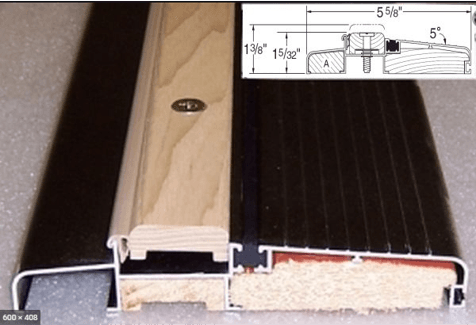
Steps are also a common feature, and hazard, in residential housing. Most residential housing in the United States sits on top of a poured concrete foundation and is constructed of wood framing. Because the wood framing is susceptible to decay if it gets wet, the concrete foundation of most homes sits above the grade of the moist surrounding soil. For this reason, there is a step to get into most homes.
Threshold ramps are a common solution to overcome the foundation step for wheelchair users and individuals with ambulatory issues that may have them using scooters, walkers, or canes. Removing the hazard of an uneven threshold and step with a threshold ramp allows for ease of mobility, fall reduction, and less burden to caregivers. It also allows those who can self-navigate the movement of their wheelchair or another ambulatory device the ability to move independently into and out of their homes.
While there are several options of ADA compliant ramps on the market, they vary significantly in cost, weight, and design. If the threshold or step is accurately measured and the correct ramp is chosen, a commercially available ramp may work well for simple steps or thresholds. However most commercially available ramps fail to adequately fit common combinations of steps and thresholds or thresholds of complex geometries that are seen in most homes. In these common situations, the ramp must be custom-fit to the threshold, a combination of ramps must be used, or the threshold must be modified. A poorly fit ramp can sometimes make the threshold or step more unsafe than the original hazard.
Current threshold ramps available on the market are typically between ½ inch to six inches high and are made of rubber or metal materials. Most are cumbersome, heavy, and difficult to fit seamlessly in standard door frames. Examples of common, current threshold ramps are:
Rubber Ramp
| Pros: | – Typically ADA compliant – Stable on uneven surfaces |
| Cons: | – Heavy – Expensive – Needs multiple sections for longer ramps – Can only be used with vertical thresholds – Strong odor of rubber – Degrades over time |
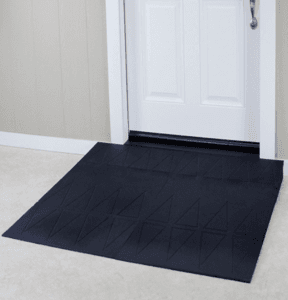
Solid Aluminum Ramp
| Pros: | – ADA compliant if measured and installed properly |
| Cons: | – Heavy – Expensive – Awkward to move – Rocks on uneven surfaces – Leading edge – Noisy – Industrial looking – Lip not large enough to cover step and threshold |
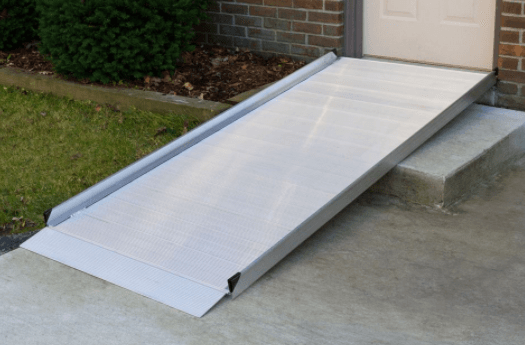
Portable Aluminum Ramps
| Pros: | – Easy to store – ADA compliant if measured and installed properly |
| Cons: | – Heavy – Expensive – Awkward to move – Rocks on uneven surfaces – Leading edge – Noisy – Industrial looking – Lip not large enough to cover step and threshold |
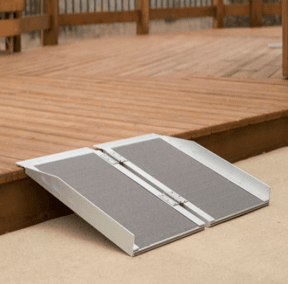
Adjustable Aluminum Ramp
| Pros: | – Lightweight (about 15 lbs)Adjustable height |
| Cons: | – Not ADA compliant – Expensive – Awkward to move – Industrial looking – Lip not large enough to cover step and threshold |
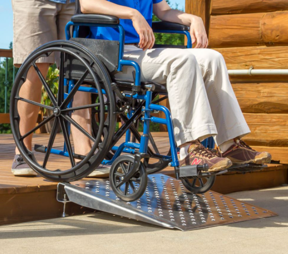
Foam Ramp
| Pros: | – Lightweight (about 15 lbs) – Easy to move |
| Cons: | – Typically not ADA compliant – Expensive – Requires multiple sections for longer ramps – Can only be used with vertical steps, not thresholds |
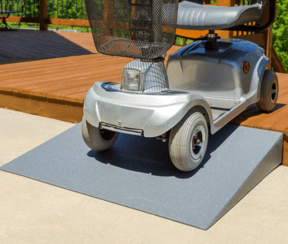
Custom Wood Ramp
| Pros: | – Customizable for the threshold – Can be ADA compliant if built properly |
| Cons: | – Expensive – Must be built on-site with a skilled worker – Requires tools to be built – Challenge to provide an entry edge small enough for transgressing – Cannot be ordered and shipped |
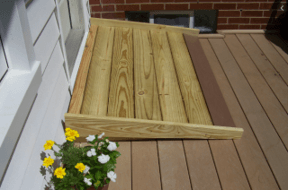
Because available ramp options often need alterations or modifications to improve the fit, stability, size, or slope of the ramp an off-the-shelf product is not ideal for most individuals needing a threshold ramp. An independent study of seven rubber or foam threshold ramps done by Sotter Engineering Corporation found that only two met the ADA requirements. Modifications to the ramp or threshold to safely allow a ramp to fit require an expert and can be expensive and time-consuming to be done properly. Oftentimes these modifications are done by a worker without ramp experience, little knowledge of ADA standards, and unawareness of the effects of small height variations on the safety of an individual with an ambulatory disability. Oftentimes the modification turns out to be ineffective or even dangerous.
Current solutions
Currently, there are three available options to make thresholds safe for those with ambulatory disabilities.
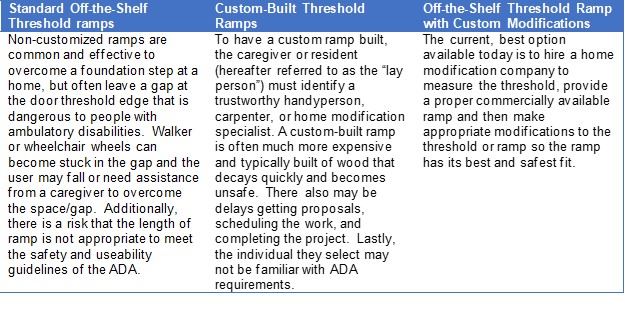
What Ramps Do You Need to Help You Access the Space You Love?
We are experts when it comes to designing the perfect ramp for your needs. Whether it be for your home or a commercial building, modular or custom, we can provide it. We can talk and walk you through the necessary lengths, widths, and slopes to meet your specific needs. Sometimes we can modify or eliminate thresholds. We may be able to install a small threshold ramp to eliminate a bump that is hanging you up. Some thresholds are challenging to modify, but we have the experience and can design a perfect solution.

